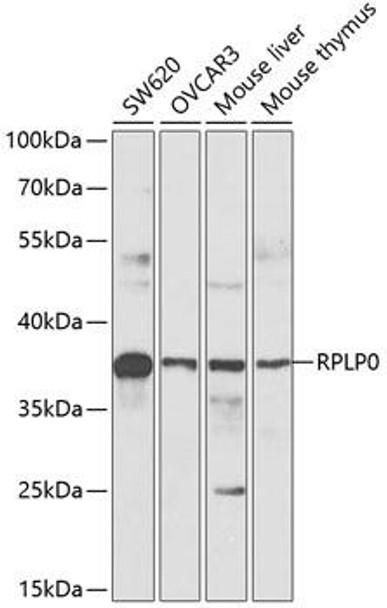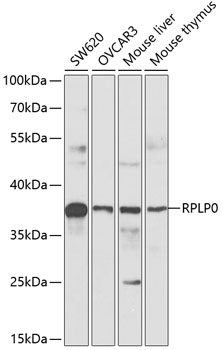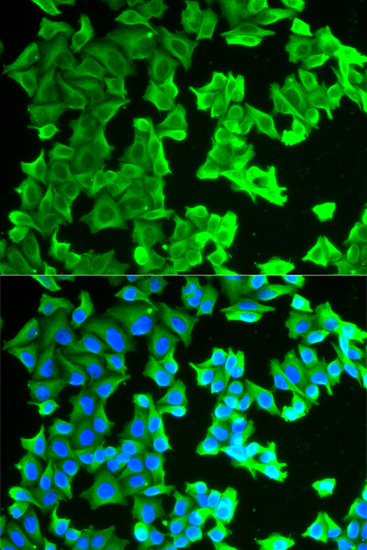Anti-RPLP0 Antibody (CAB13633)
- SKU:
- CAB13633
- Product type:
- Antibody
- Reactivity:
- Human
- Mouse
- Host Species:
- Rabbit
- Isotype:
- IgG
- Antibody Type:
- Polyclonal Antibody
- Research Area:
- Immunology
Frequently bought together:
Description
| Antibody Name: | Anti-RPLP0 Antibody |
| Antibody SKU: | CAB13633 |
| Antibody Size: | 20uL, 50uL, 100uL |
| Application: | WB IF |
| Reactivity: | Human, Mouse |
| Host Species: | Rabbit |
| Immunogen: | Recombinant fusion protein containing a sequence corresponding to amino acids 1-317 of human RPLP0 (NP_000993.1). |
| Application: | WB IF |
| Recommended Dilution: | WB 1:500 - 1:2000 IF 1:50 - 1:200 |
| Reactivity: | Human, Mouse |
| Positive Samples: | SW620, OVCAR3, Mouse liver, Mouse thymus |
| Immunogen: | Recombinant fusion protein containing a sequence corresponding to amino acids 1-317 of human RPLP0 (NP_000993.1). |
| Purification Method: | Affinity purification |
| Storage Buffer: | Store at -20°C. Avoid freeze / thaw cycles. Buffer: PBS with 0.02% sodium azide, 50% glycerol, pH7.3. |
| Isotype: | IgG |
| Sequence: | MPRE DRAT WKSN YFLK IIQL LDDY PKCF IVGA DNVG SKQM QQIR MSLR GKAV VLMG KNTM MRKA IRGH LENN PALE KLLP HIRG NVGF VFTK EDLT EIRD MLLA NKVP AAAR AGAI APCE VTVP AQNT GLGP EKTS FFQA LGIT TKIS RGTI EILS DVQL IKTG DKVG ASEA TLLN MLNI SPFS FGLV IQQV FDNG SIYN PEVL DITE ETLH SRFL EGVR NVAS VCLQ IGYP TVAS VPHS IING YKRV LALS VETD YTFP LAEK VKAF LADP SAFV AAAP VAAA TTAA PAAA AAPA KVEA KEES EESD EDMG FGLF D |
| Gene ID: | 6175 |
| Uniprot: | P05388 |
| Cellular Location: | Cytoplasm, Nucleus |
| Calculated MW: | 27kDa/34kDa |
| Observed MW: | 37kDa |
| Synonyms: | RPLP0, L10E, LP0, P0, PRLP0, RPP0 |
| Background: | Ribosomes, the organelles that catalyze protein synthesis, consist of a small 40S subunit and a large 60S subunit. Together these subunits are composed of 4 RNA species and approximately 80 structurally distinct proteins. This gene encodes a ribosomal protein that is a component of the 60S subunit. The protein, which is the functional equivalent of the E. coli L10 ribosomal protein, belongs to the L10P family of ribosomal proteins. It is a neutral phosphoprotein with a C-terminal end that is nearly identical to the C-terminal ends of the acidic ribosomal phosphoproteins P1 and P2. The P0 protein can interact with P1 and P2 to form a pentameric complex consisting of P1 and P2 dimers, and a P0 monomer. The protein is located in the cytoplasm. Transcript variants derived from alternative splicing exist; they encode the same protein. As is typical for genes encoding ribosomal proteins, there are multiple processed pseudogenes of this gene dispersed through the genome. |
| UniProt Protein Function: | RPLP0: a ribosomal protein of the L10P family. Located in the cytoplasm and nucleus. Ribosomes, the organelles that catalyze protein synthesis, consist of a small 40S subunit and a large 60S subunit. Together these subunits are composed of 4 RNA species and approximately 80 structurally distinct proteins. This protein is a component of the 60S subunit. |
| UniProt Protein Details: | Protein type:Ribosomal; Translation Chromosomal Location of Human Ortholog: 12q24.2 Cellular Component: cytoplasm; cytosol; focal adhesion; membrane; nucleus; ribonucleoprotein complex Molecular Function:protein binding; structural constituent of ribosome Biological Process: mRNA catabolic process, nonsense-mediated decay; rRNA processing; SRP-dependent cotranslational protein targeting to membrane; translational initiation; viral transcription |
| NCBI Summary: | Ribosomes, the organelles that catalyze protein synthesis, consist of a small 40S subunit and a large 60S subunit. Together these subunits are composed of 4 RNA species and approximately 80 structurally distinct proteins. This gene encodes a ribosomal protein that is a component of the 60S subunit. The protein, which is the functional equivalent of the E. coli L10 ribosomal protein, belongs to the L10P family of ribosomal proteins. It is a neutral phosphoprotein with a C-terminal end that is nearly identical to the C-terminal ends of the acidic ribosomal phosphoproteins P1 and P2. The P0 protein can interact with P1 and P2 to form a pentameric complex consisting of P1 and P2 dimers, and a P0 monomer. The protein is located in the cytoplasm. Transcript variants derived from alternative splicing exist; they encode the same protein. As is typical for genes encoding ribosomal proteins, there are multiple processed pseudogenes of this gene dispersed through the genome. [provided by RefSeq, Jul 2008] |
| UniProt Code: | P05388 |
| NCBI GenInfo Identifier: | 133041 |
| NCBI Gene ID: | 6175 |
| NCBI Accession: | P05388.1 |
| UniProt Secondary Accession: | P05388,Q3B7A4, Q9BVK4, |
| UniProt Related Accession: | P05388 |
| Molecular Weight: | 27,436 Da |
| NCBI Full Name: | 60S acidic ribosomal protein P0 |
| NCBI Synonym Full Names: | ribosomal protein lateral stalk subunit P0 |
| NCBI Official Symbol: | RPLP0 |
| NCBI Official Synonym Symbols: | P0; LP0; L10E; RPP0; PRLP0 |
| NCBI Protein Information: | 60S acidic ribosomal protein P0 |
| UniProt Protein Name: | 60S acidic ribosomal protein P0 |
| UniProt Synonym Protein Names: | 60S ribosomal protein L10E |
| UniProt Gene Name: | RPLP0 |
| UniProt Entry Name: | RLA0_HUMAN |








